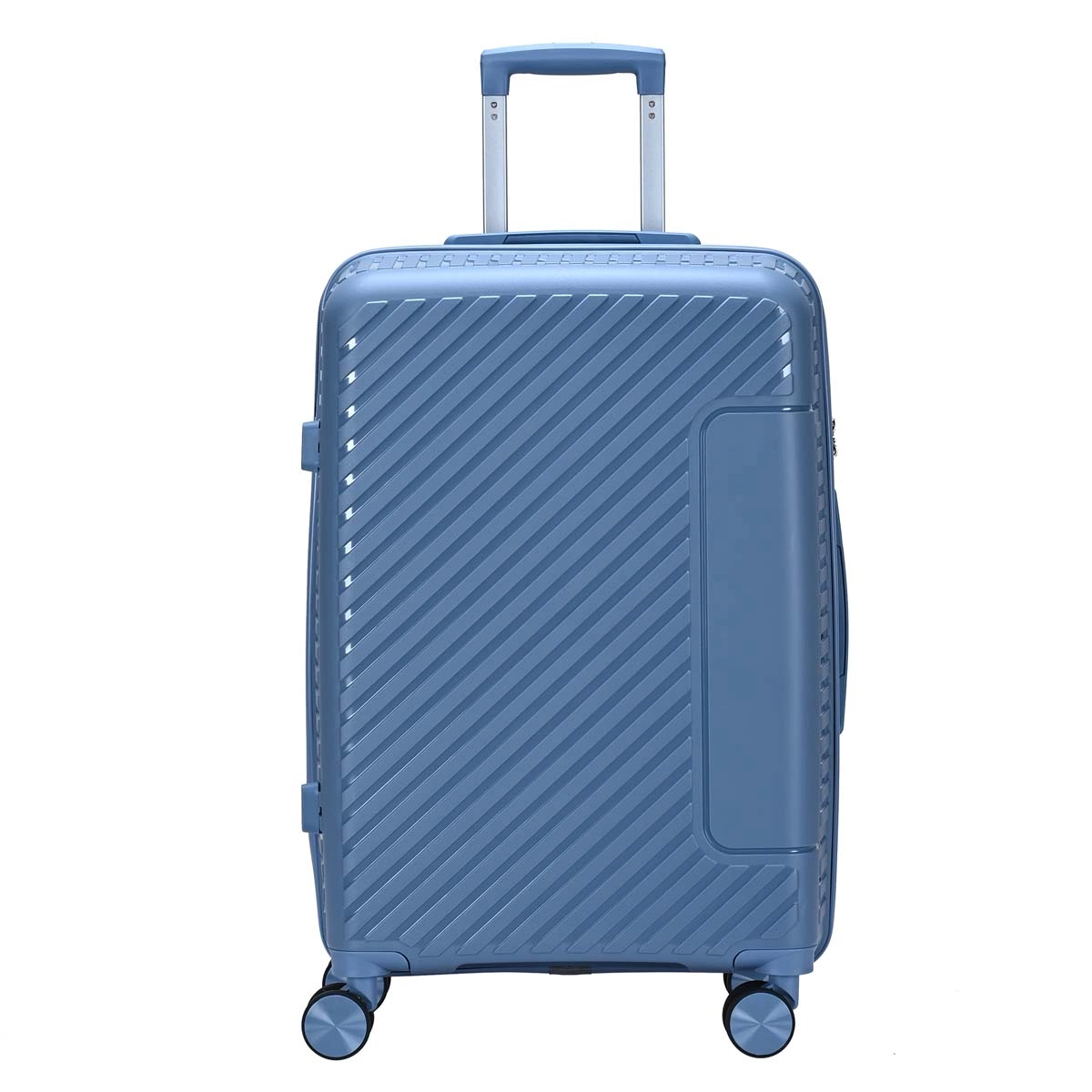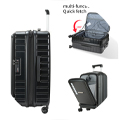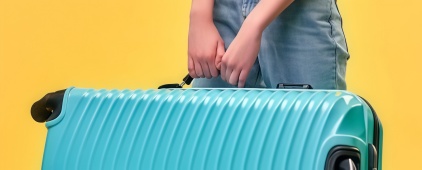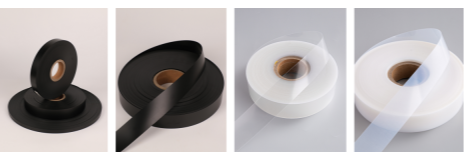Luggage Microbiome: How Bacteria Behave on Fabric vs Hard-Shell Surfaces
Luggage Microbiome: How Bacteria Behave on Fabric vs Hard-Shell Surfaces

When we think about trip cleanliness, our minds often go to shared bathrooms or plane food spots. But we seldom think about the bags we pull through travel hubs, stays, and paths. Yet, your case may be holding a hidden group: a bunch of germs gathered from every spot it touches. Seeing how different bag stuff—soft vs. firm—works with germs can help people on trips make wiser picks for safer and neater paths.
What Is the Luggage Microbiome and Why Does It Matter?
Before going into stuff differences, it is key to see what the luggage microbiome is. And why it should worry you.
The Concept of Microbial Presence on Travel Gear
Bags act as a moving spot that meets many places during trips. From travel hub floors to stay beds, each stop brings new germ dwellers. These tiny things can include safe outdoor germs. But they can also have bad ones that bring health dangers.
How Luggage Interacts with Different Environments
You wheel your case through a crowded spot. Or you put it in an upper bin. Your bag gets open to busy shared places. These spots get cleaned less often than thought. So, they turn into main areas for germ move.
Factors Influencing Microbial Accumulation During Travel
Many things add to germ build on bags. Trip time matters. Wet places matter too. Kind of move used counts. And how often others touch it. Each thing adds one more part to your bag’s unseen germ weight.
You can pick small bags for these times. For brief trips or fast end-of-week escapes. To cut costs and shorten wait at bag pick spots. To skip bag fees. And make sure quick leaves without wait for big bags.
Pengteng knows that each path opens your bag to many places where germs grow well. Their plan way looks at these facts by focusing on stuff that fights germ build.
How Do Bacteria Differ Between Fabric and Hard-Shell Surfaces?
Not all bag stuff is the same when it comes to holding germs. The changes between soft and firm spots are big in terms of cleanness.
Surface Porosity and Its Role in Bacterial Retention
Soft spots are holey. They give small gaps where germs can stay safe. On the other hand, firm bags have a flat outside. This makes it tougher for germs to stick and last long.
Moisture Absorption and Microbial Growth
Soft tends to take in wet from rain or damp states. This makes a great spot for germ growth. Firm stuff pushes water away better. So, it cuts this danger a lot.
Cleaning Frequency and Material Resistance to Contaminants
Firm cases are simpler to clean with dirt killers after each trip. Soft bags need more hard cleaning ways like sucking dust or washing with special germ killers. Most people on trips skip these jobs all together.
Pengteng sees these tough spots. It gives bag items made from no-hole stuff that fights wet take-in. And lets easy cleaning. This is great for keeping cleanness during often trips.
Which Types of Bacteria Are Commonly Found on Luggage?
Seeing what kinds of germs might be riding on your case can help show why right stuff pick and cleaning habits matter.
Environmental Bacteria from Airports, Hotels, and Public Transit
These include dirt-based germs taken from floors or dust bits in air holes. Though many are safe, some may start allergies or breathing troubles over time.
Skin-Associated Microbes Transferred Through Handling
Each time you touch your bag, or another does, you move skin group like Staphylococcus epidermidis. While usually good, these germs can turn bad if they get into cuts or touchy spots.
Potential Pathogenic Strains and Their Risks
Studies have seen kinds like E.coli or even MRSA on busy touch spots in shared places. This includes bag holds. These bad germs bring real health dangers if not handled right through cleaning.
Pengteng handles this worry by planning their items with germ-fight spots that cut chances of bad germs lasting on your gear after open in move-busy areas.
Can Material Choice Influence Hygiene During Travel?
Yes. Stuff pick can change cleanness during trips. It plays a main role in how well your bag fights germ dirt through its life.
Comparative Durability Against Bacterial Colonization
Firm stuff like polycarbonate gives fewer chances for germs to settle because of their no-hole kind. Soft bags tend to break down quicker. They catch more dirt over time.
Ease of Sanitization for Fabric vs. Hard-Shell Options
Cleaning a firm case needs only a simple clean with dirt killer cloths or sprays. Soft choices ask for deeper cleaning. Many users skip it because of hassle.
Implications for Frequent Travelers and Families
For those who go often, or with kids, the danger of mix dirt grows a lot. Picking easy clean firm choices turns not just handy but needed for keeping health levels on the move.
Pengteng’s item fresh ideas put first clean plan through tough stuff that fights both break and germ settle. This makes them great friends for groups and work people on trips alike.
What Are the Best Practices to Minimize Exposure to Harmful Microbes?

Even with the right stuff pick, active steps can more cut germ open during trips.
Regular Cleaning Techniques for Different Luggage Types
Use drink-based cloths or sprays after each trip for firm kinds. For soft bags, think about hot air cleaning or using cloth-safe germ killers often.
Use of Protective Covers and Sanitizing Sprays
Guard covers not only keep dust away. They also make an extra wall against germs taken in move centers like travel hubs or ride spots.
Storage Tips to Reduce Long-Term Contamination
Keep your bag in dry spots away from wet low rooms or tight spots where mold may grow unseen over time. Always take out inside fully before keeping after trip.
Pengteng makes its items with easy keep in mind. This lets users clean quick while making sure long-time tough against germ threats usual during keep times between trips.
Who Is Pengteng and What Makes Their Luggage Products Stand Out?
As knowing grows around cleanness-focused trip gear, Pengteng shines as a name set on both plan top and cleanness levels.
Pengteng’s Commitment to High-Quality Materials and Design
By picking top-level stuff fight to break as well as germ stick, Pengteng makes sure their items meet current people on trips needs without hurting looks or work.
Professional Standards in Manufacturing Clean-Friendly Luggage
Pengteng sticks tight to expert making steps that put first cleanness. From stuff get through last put together. This makes sure every bit gives better fight against outdoor dirt taken during trip habits.
Product Innovations Focused on Durability and Hygiene
From germ-fight layers on holds to water-fight closers and insides planned for easy clean. Pengteng puts in careful traits that back neater paths without extra work for users.
Conclusion
Your case is more than just a holder. It is an busy part in your trip feel that works always with different places full of germs. Seeing how different stuff affects germ build helps you make smarter picks about what you pack. And what packs with you. With names like Pengteng leading in clean-friendly plan fresh ideas, people on trips now have better items than ever to go safe.
FAQs
Q1: Is hard-shell luggage more hygienic than fabric luggage?
A: Yes, hard-shell luggage is generally more hygienic due to its non-porous surface which makes it easier to clean and less likely to retain moisture where bacteria thrive compared to fabric alternatives.
Q2: Can bacteria on luggage make you sick?
A: Yes, certain pathogenic strains like E.coli or MRSA found on high-touch surfaces including luggage can potentially cause illness if they come into contact with vulnerable parts of your body such as cuts or mucous membranes.
Q3: How often should I clean my luggage?
A: It’s recommended to clean your luggage after every trip—especially if it’s been exposed extensively in public areas like airports or hotels—to minimize bacterial accumulation over time.









